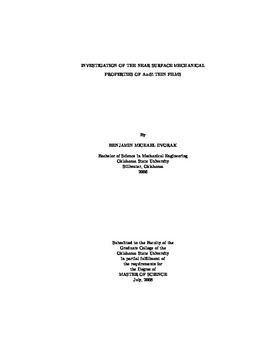| dc.contributor.advisor | Lucca, Don A. | |
| dc.contributor.author | Dvorak, Benjamin Michael | |
| dc.date.accessioned | 2014-04-17T19:52:17Z | |
| dc.date.available | 2014-04-17T19:52:17Z | |
| dc.date.issued | 2008-07-01 | |
| dc.identifier.uri | https://hdl.handle.net/11244/9924 | |
| dc.description.abstract | An investigation of the material properties of polycrystalline Au films and the effect of Si content on the material properties and structure of co-evaporated Au-Si films has been performed. Atomic Force Microscopy (AFM), nanoindentation and four-point probe were utilized to investigate the surface topography, mechanical and electrical properties of these films, respectively. X-ray Diffraction (XRD) and Transmission Electron Microscopy (TEM) measurements were performed to investigate the material crystallography and structure.The hardness of pure Au films was found to be approximately 1.2 GPa and increased by about 40 - 80% (1.64 GPa - 2.13 GPa) by the addition of 2.5 and 6 at. % Si, respectively and approximately 102% to 2.41 GPa by the addition of 21 at. % Si. The film resistivity increased nearly linearly from 5.58 - 38.15 ??-cm as the Si content increased from 2.5 - 21 at. %, respectively.XRD measurements on the Au/21 at. % Si film suggested the formation of an unknown crystalline Au-Si phase. The metastability of this phase was shown experimentally by performing a second XRD measurement on the same specimen after an 8 week room temperature storage period which indicated that the unknown Au-Si surface phase present had almost completely dissociated. The hardness and reduced elastic modulus decreased by approximately 32% from 2.41 - 1.65 GPa and 53% from 88 - 41.5 GPa, respectively.TEM measurements, conducted on an Au/25 at. % Si specimen, showed the nanocrystalline grain structure of the Au, with an average grain size of 18 nm (consistent with the XRD measurement), with a dispersion of amorphous Si particles approximately 1 - 5 nm in diameter. From these results, the predicted hardness increase of the Au-Si film resulting from the Orowan hardening mechanism was estimated to be H Orowan ? 0.05 GPa - 1.07 GPa representing approximately 4 - 88% of the overall hardness increase measured for the Au/21 at. % Si film assuming the same Si content for the TEM specimens. The estimated H Orowan range suggested that additional mechanisms, such as the Hall-Petch effect, may be responsible for the measured hardness increase. | |
| dc.format | application/pdf | |
| dc.language | en_US | |
| dc.publisher | Oklahoma State University | |
| dc.rights | Copyright is held by the author who has granted the Oklahoma State University Library the non-exclusive right to share this material in its institutional repository. Contact Digital Library Services at lib-dls@okstate.edu or 405-744-9161 for the permission policy on the use, reproduction or distribution of this material. | |
| dc.title | Investigation of the Near Surface Mechanical Properties of Au-si Thin Films | |
| dc.type | text | |
| dc.contributor.committeeMember | Price, C. Eric | |
| dc.contributor.committeeMember | Lu, Hongbing | |
| osu.filename | Dvorak_okstate_0664M_2862.pdf | |
| osu.college | Engineering, Architecture, and Technology | |
| osu.accesstype | Open Access | |
| dc.description.department | Mechanical & Aerospace Engineering | |
| dc.type.genre | Thesis | |
